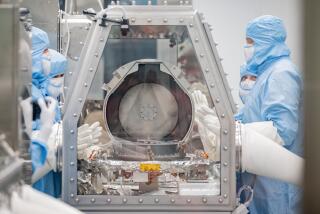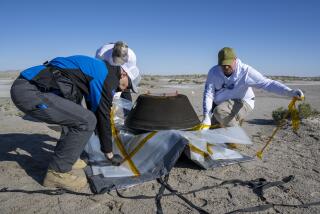NASA Curiosity rover shows off historic scoop of Mars rock
NASA’s Curiosity rover has successfully collected its first sample from inside a Martian rock – and the robot geologist has the photo to prove it, Jet Propulsion Laboratory officials said.
The Mars Science Laboratory rover sent back images of its scoop cradling roughly a tablespoon of grayish powdered rock from Yellowknife Bay -- a historic first that takes the surface-scratching of previous rover missions to new depths, mission scientists and engineers at the La Cañada Flintridge lab said Wednesday.
Earlier this month, the NASA team used the drill on the rover’s arm to bore a hole 0.63 of an inch wide and 2.5 inches deep into a rock known as John Klein, named after a deputy mission project scientist who died in 2011. They then used ground-up rock to swish around and clean out the sample chambers around the bit before depositing it into the scoop.
“We’re all very happy to get this confirmation, and relieved the drilling was a complete success,” said drill systems engineer Scott McCloskey.
In the coming days, the rover will shake and sieve the sample through 0.006-of-an-inch holes in an apparatus that lead systems engineer Daniel Limonadi called “our martini mixer on the spacecraft.” It will then transfer the powdered rock into a laboratory in the rover’s belly, where the CheMin instrument and later the Sample Analysis at Mars suite will analyze the rock’s chemical properties and mineral structure.
The drill’s use is a landmark, the culmination of a series of tests as Curiosity has carefully and methodically checked its systems since landing in Gale Crater on Aug. 5.
Scientists ran a shallow dress-rehearsal drilling on Mars two days before they dug out their Feb. 8 sample. And here on Earth, said sample system chief engineer Louise Jandura, engineers have drilled more than 1,200 holes in about 20 types of rock on Earth for practice.
“It’s a real big turning point for us,” said the mission’s lead scientist, Caltech geologist John Grotzinger. Recently, he added, mission engineers “sort of had a passing of the keys of the rover to the science team.”
The researchers say they’re already looking forward to what Curiosity’s high-tech internal lab will reveal about the samples, said sampling system scientist Joel Hurowitz. The grayish color of the rock – so unlike Mars’ reddish surface – has already caught a few eyes.
“This is something the science team is really excited about,” Hurowitz said. “When things turn orange it’s because there’s a rusting process … that oxidizes the iron in the rock.”
If these rocks did not go through that process, he added, “it may preserve some indication of what iron was doing in these samples.”
Follow me on Twitter @aminawrite.







